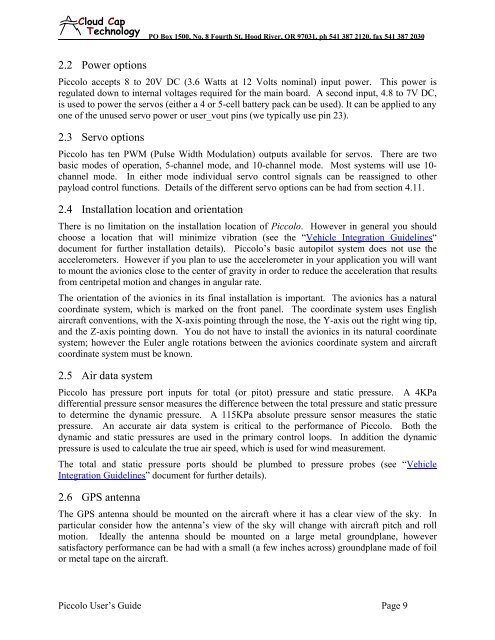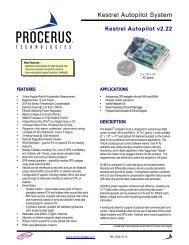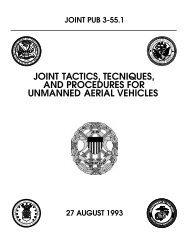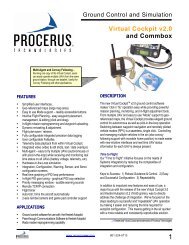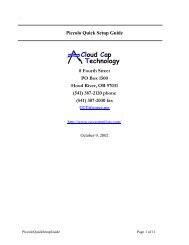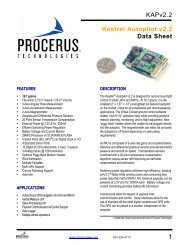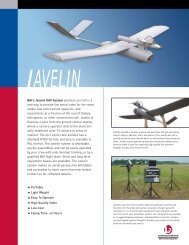Piccolo system user guide - Unmanned Aircraft & Drones
Piccolo system user guide - Unmanned Aircraft & Drones
Piccolo system user guide - Unmanned Aircraft & Drones
Create successful ePaper yourself
Turn your PDF publications into a flip-book with our unique Google optimized e-Paper software.
Clo ud Cap<br />
Technology<br />
PO Box 1500, No. 8 Fourth St, Hood River, OR 97031, ph 541 387 2120, fax 541 387 2030<br />
2.2 Power options<br />
<strong>Piccolo</strong> accepts 8 to 20V DC (3.6 Watts at 12 Volts nominal) input power. This power is<br />
regulated down to internal voltages required for the main board. A second input, 4.8 to 7V DC,<br />
is used to power the servos (either a 4 or 5-cell battery pack can be used). It can be applied to any<br />
one of the unused servo power or <strong>user</strong>_vout pins (we typically use pin 23).<br />
2.3 Servo options<br />
<strong>Piccolo</strong> has ten PWM (Pulse Width Modulation) outputs available for servos. There are two<br />
basic modes of operation, 5-channel mode, and 10-channel mode. Most <strong>system</strong>s will use 10-<br />
channel mode. In either mode individual servo control signals can be reassigned to other<br />
payload control functions. Details of the different servo options can be had from section 4.11.<br />
2.4 Installation location and orientation<br />
There is no limitation on the installation location of <strong>Piccolo</strong>. However in general you should<br />
choose a location that will minimize vibration (see the “Vehicle Integration Guidelines“<br />
document for further installation details). <strong>Piccolo</strong>’s basic autopilot <strong>system</strong> does not use the<br />
accelerometers. However if you plan to use the accelerometer in your application you will want<br />
to mount the avionics close to the center of gravity in order to reduce the acceleration that results<br />
from centripetal motion and changes in angular rate.<br />
The orientation of the avionics in its final installation is important. The avionics has a natural<br />
coordinate <strong>system</strong>, which is marked on the front panel. The coordinate <strong>system</strong> uses English<br />
aircraft conventions, with the X-axis pointing through the nose, the Y-axis out the right wing tip,<br />
and the Z-axis pointing down. You do not have to install the avionics in its natural coordinate<br />
<strong>system</strong>; however the Euler angle rotations between the avionics coordinate <strong>system</strong> and aircraft<br />
coordinate <strong>system</strong> must be known.<br />
2.5 Air data <strong>system</strong><br />
<strong>Piccolo</strong> has pressure port inputs for total (or pitot) pressure and static pressure. A 4KPa<br />
differential pressure sensor measures the difference between the total pressure and static pressure<br />
to determine the dynamic pressure. A 115KPa absolute pressure sensor measures the static<br />
pressure. An accurate air data <strong>system</strong> is critical to the performance of <strong>Piccolo</strong>. Both the<br />
dynamic and static pressures are used in the primary control loops. In addition the dynamic<br />
pressure is used to calculate the true air speed, which is used for wind measurement.<br />
The total and static pressure ports should be plumbed to pressure probes (see “Vehicle<br />
Integration Guidelines” document for further details).<br />
2.6 GPS antenna<br />
The GPS antenna should be mounted on the aircraft where it has a clear view of the sky. In<br />
particular consider how the antenna’s view of the sky will change with aircraft pitch and roll<br />
motion. Ideally the antenna should be mounted on a large metal groundplane, however<br />
satisfactory performance can be had with a small (a few inches across) groundplane made of foil<br />
or metal tape on the aircraft.<br />
<strong>Piccolo</strong> User’s Guide Page 9


